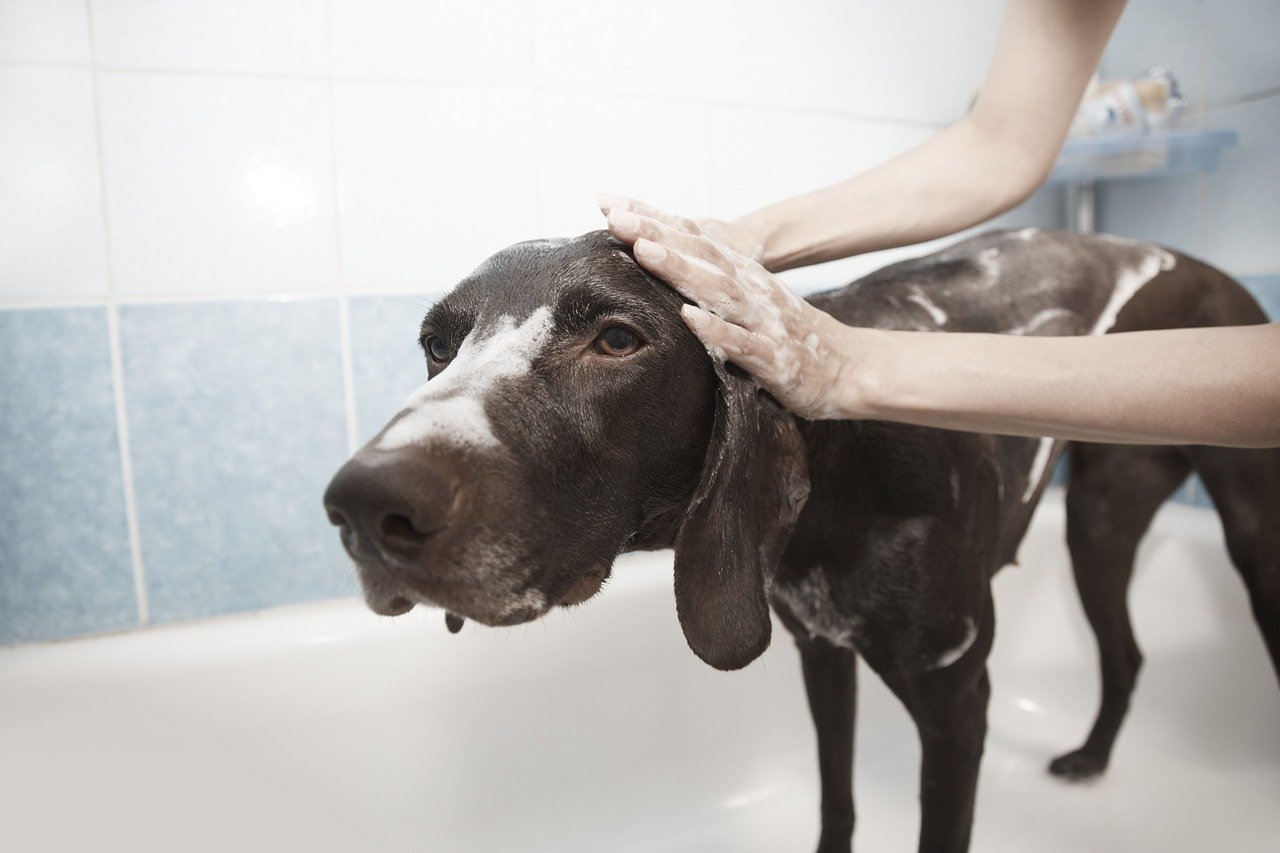
How Often Should I Bathe or Groom My Dog or Cat?
Dogs and cats, much like humans, need regular grooming for proper hygiene and overall health. The extent of that grooming will depend on a variety of factors, including your pet’s breed, health and lifestyle. A dog also has very different bathing and grooming needs than a cat.
These bathing and grooming tips will give you a starting point to help your pet look, feel and smell his or her best.
Dogs
How Often Should I Bathe My Dog?
As a veterinarian, one of the questions I get most is, “How often should I bathe my dog?” The answer depends on a few things. First, what breed is your dog? Short-hair dogs, such as German Shorthaired Pointers, can typically go longer in between baths. Their coats naturally shed dirt and oil.
However, it’s not just about the length of their coat. Some breeds with short hair, like the Basset Hound, tend to have oilier skin, which might mean they need a more regular cleaning.
Generally speaking, it’s a good idea to bathe your dog at least once a month. If they seem overly dirty or smelly, you can always up the frequency in a given month. If you notice their skin looks dried out, however, check with your veterinarian to see if you should tailor back on their baths or, at the least, switch shampoos.
How to Bathe a Dog
Before bathing your dog, you’ll need to get a few supplies, including:
A veterinarian-recommended shampoo for your dog’s breed (never use a shampoo or conditioner made for humans on a dog)
Dog brush
Grooming glove or grooming tool (pet owners seem to love this Aquapaw Pet Bathing Tool)
Nonslip, waterproof shower or bath mat for your dog to stand on
Waterproof collar and leash
Towels
Dog treats
A cushion for you to kneel on
Next, choose your location: inside in the bathroom or outside with a hose. It’s really a matter of personal preference for both you and your dog. Outside means less clean-up after the bath, but the water temperature may be a little colder. If you opt for indoors, pet owners tend to prefer using a removable showerhead nozzle, which allows you to control the water pressure and temperature.
Prepare the area, setting up your supplies. Make sure your dog is wearing a collar and leash, in case they try to run away mid-bath. Using the removable showerhead, wet your dog’s coat from the rear forward, underneath their belly and along each leg and paws. Using the grooming glove or tool, massage the dog-formulated shampoo into her coat. Follow the directions on the bottle and then rinse when finished.
Dry off your dog’s coat with the towel, which will most certainly be their favorite part. Keep treats handy to reward your dog after the bath.
A Checklist of Regular Grooming Needs for Your Dog
Coat brushing – Brushing a dog’s coat benefits the pet and the owner alike. For the pet, it removes dirt and distributes their natural oils throughout their coat. It also prevents matting. For the owner, it helps reduce shedding around the house. Win-win! Ask your veterinarian how often you should brush your dog and what type of brush to buy, based on her breed and coat.
Ear cleaning – Start by gently folding back your dog’s ear. Dampen a cotton ball with liquid ear cleaner formulated for dogs. If you can see wax or debris, lift it (don’t rub) using the cotton ball. Do not insert anything into your dog’s ear canal, as that could cause damage. Each time your dog gets a bath (at least once a month), check their ears and clean as needed.
Nail trimming – Are your dog’s nails touching the ground when she walks? That’s a sign they need trimming. You can take the dog into a professional groomer to get their nails trimmed or do it yourself, using these tips from the American Society for the Prevention of Cruelty to Animals (ASPCA).
Teeth – Dogs, like humans, need their teeth brushed regularly. Some experts recommend twice daily or three times a week (minimum). If your dog has never had his teeth brushed, consider introducing each element slowly and by itself. Start off by using a washcloth and rubbing it over her teeth, using a back and forth motion. Next, allow your dog to lick a dog-formulated toothpaste from your finger. Then put a dab of the toothpaste on the damp washcloth to “brush” the teeth. Once your dog has gotten used to this process, replace the washcloth with a toothbrush.
Cats
How Often Should I Bathe My Cat?
You’ve probably noticed that your cat is always licking her coat. That’s because cats are self-groomers. They don’t typically need regular baths like dogs do. However, there are some exceptions. Maybe your cat decides to take a mud bath in your backyard. Or your cat is overweight or older and is no longer able to sufficiently clean their coat. If the need for a bath arises, you can certainly give your cat one.
How to Bathe a Cat
Cats don’t love water, as you might have noticed. As such, make sure your cat’s nails have been recently trimmed before attempting to give her a bath. That’s going to help ensure you stay friends after the bath.
Next, prepare the items you’ll need, including:
A veterinarian-recommended shampoo made for cats (similar to dogs, never use a shampoo or conditioner made for humans on a cat)
Cat brush
Nonslip, waterproof shower mat for your cat to stand on
Removeable showerhead nozzle
Waterproof collar and leash
Towels
Cat treats
A cushion for you to kneel on
If possible, use a shower with a removable nozzle, as opposed to submerging them in a bath (which they won’t love). Keep the water the same temperature as you would use to bath a baby (lukewarm). Use the showerhead nozzle to dampen their coat, working from their rear forward. Avoid their face. Lather on the shampoo, following the instructions on the bottle. Follow the same steps to rinse off the shampoo, starting from the rear forward and avoiding the face. When you’re finished, dry your cat with a towel and use fragrance-free cat eye wipes to gently clean their face. Give your cat treats after the bath to ensure that they’ll let you do it again, if and when it’s necessary.
There are also a number of waterless shampoos for cats you can use as needed.
A Checklist of Regular Grooming Needs for Your Cat
Baths should be a rarity for your self-grooming cat. However, there are other grooming needs that your cat will need your assistance with, including:
Coat brushing – One to two times per week, brush your cat’s coat. This helps to remove dirt, grease and dead hair. It can also help to stimulate blood circulation.
- Ear cleaning – Check your cat’s ears once a week for wax, debris or infection. Healthy inner ears will be pale pink in color. For general cleaning, put some liquid ear cleaner formulated for this purpose on a cotton ball. Next, gently fold the cat’s ear back and lift away any visible dirt or wax on the underside of the ear. Important: Do not clean the ear canal, which can cause damage.
Nail trimming – Every two weeks, your cat’s nails will likely need a trim. You’ll likely have the best (and safest) experience if this is done by a professional groomer. However, the ASPCA provides step-by-step instructions for paw and nail care at home if you need to go that route.
Teeth – To keep your cat’s teeth and gums healthy, brush them gently a few times a week. Make sure to get a toothbrush and toothpaste that is specifically made for cats, not humans. The toothbrush will be smaller and have softer bristles. Use a cotton swab at first, without toothpaste, to slowly get your cat used to the idea. Then introduce a cat-formulated toothpaste. Finally, work your way up to using the cat specific toothbrush with the toothpaste, once they’ve gotten acclimated to the process.
Would you rather get your pet professionally groomed? Many large pet stores, including Petco, offer this service. Your veterinarian’s office is another great option, particularly if your pet has any health issues at the time of grooming.
Whether you’re grooming your pet at home or hiring a professional, it’s important to stay on top of it, in order to keep your pet healthy and clean.
Your pet — and your nose — will thank you.

